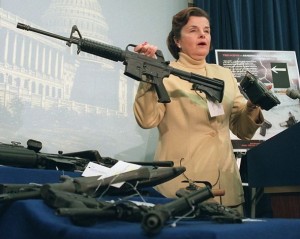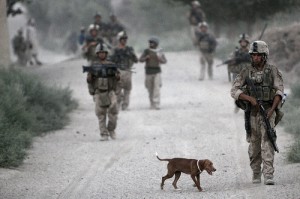Do We Have A Constitutional Right To Own An AR?
BY Herschel SmithThe AR is in the news lately, much maligned, and much misunderstood. We have already discussed the notion of the AR (most Americans purchase) being an assault rifle, explaining that it is no such thing since for a weapon to be an assault rifle it must have selective fire capability. “Assault weapon” is a political phrase that is meant to convey the idea of weapons being scary.
But the hatred of the things that characteristize the politically-defined assault weapon (high capacity magazines, forend grips, etc.) pours from the editorial pages in newspapers all across the country today. For a few examples consider Robert in New York:
In Colonial times, weapons for individuals were limited to flintlock rifles and pistols. These had utility for food-gathering and home defense. These weapons were powder-and-ball, single-shot, and slow to reload laboriously by hand, and of limited range and accuracy.
Nowadays we have graduated to semiautomatic assault weapons, intended for military use and the killing or maiming of as many enemies as possible in battle. They can fire hundreds of rounds per minute. There was a ban on them for private sale and use in recent years, but it has since been struck down.
Does anyone think they are critical for home defense, bringing down a rabbit, a deer, or for target practice?
Next, consider Joan in Vero Beach:
I am struck that the killer once again had an assault weapon and was able to legally purchase it and the magazines in local stores and off the Internet because of the bullying tactics of Wayne LaPierre and his gutless minions in Congress.
I have spent many a happy time with my dogs at hunt tests safely using a gun. I am not against responsible gun ownership but assault weapons have no place in the possession of anyone but law enforcement or the military and certainly not legally accessible on the Internet.
LaPierre and his minions will wait for the storm of their refusal to agree to the need of rational gun laws to settle down and then they will raise their usual baseless arguments against any laws that prohibit people from freely purchasing assault weapons even as the families of victims in Aurora, Tucson and Columbine daily grieve the loss of their loved ones, who were only doing the things that we all do every day.
Finally, consider Roland Martin, CNN contributor:
To all of you gun lovers, feel free to go buy your Glock, shotgun, hunting rifle, .22 pistol, .357 Magnum or any of the other guns at your disposal.
But you do not need an AK-47.
For some, it’s too soon to discuss gun reform, a little more than one week after the mass killings in Aurora, Colorado. I disagree. Too many Americans are being killed by guns every day; this most recent heinous tragedy should not keep us from having a rational debate.
[ … ]
Seriously, please offer me a reasonable and rational explanation as to why someone who isn’t a law enforcement officer needs to fire off that many bullets?
Well, since Mr. Martin demanded, let’s engage that debate with him. As I have pointed out, it simply isn’t true that America is refusing to engage in debate over guns. That’s all we’ve been doing for more than a week now. It’s just that anti-firearms folks are losing the argument, so it gets louder with each day and for each new commentary.
Regarding defense of my person and my home and family, what happens if Robert, or Joan or Roland restrict me to a muzzle loading weapon and I miss my assailant? After all, shooting your weapon is a perishable skill and I only get to the range once a week or every two weeks. What happens if I neglect to practice my “fail to stop” drills or my first or second or third shot miss my assailant? What happens if I am using my AR and neglect to compensate my aim for sight “height over bore” and miss my assailant badly enough to wound him but not kill him, and he keeps coming after me?
What happens if the threat is from a multiple-assailant home invasion and I must produce a large volume of fire very rapidly in order to effect proper self defense? Consider this five-man home invasion in Tulsa.
A second suspect in the attack on a Tulsa minister was arrested Tuesday night, Tulsa police said.
Markedrik Delmar Wilson, 26, was arrested about 8:40 p.m. after a witness identified him as one of five men who forced their way into the Rev. Kenneth Brooks’ home in the 2700 block of North Denver Avenue shortly before 2 a.m. Tuesday, according to police and reports.
One of the men shot Brooks point-blank in the chest and then the group fled, police said.
Or perhaps consider this home invasion in Wareham, Massachusetts.
Five men accused of a home invasion in Wareham where two women say they were raped are now facing Superior Court charges.
All five are charged with four counts of masked armed robbery and one count of armed home invasion. Santiago and Gomes are charged with aggravated rape and Williams is being charged with unlawful possession of a firearm without an FID card.
Is this enough to demonstrate the point? Perhaps not. Then consider yet another five-man home invasion in Glenolden, Pennsylvania.
A group of men – at least one armed with a gun – invaded a borough home early Wednesday and terrorized several people inside, including one who was pistol-whipped, according to NBC-10.
The violence incident unfolded about 1:45 a.m., when a group of four or five men broke into a at near the intersection of Elmwood and Ashland avenues, police said. At least one of the intruders was armed with a handgun.
Four people were inside the home at the time and one of the residents was pistol-whipped, police said.
Have you considered this four-man home invasion in Philadelphia? Or how about this three-man home invasion in Charlotte, North Carolina? Or this three-man home invasion in Franklin Country, Alabama? Or this three-man home invasion in Pawtucket?
Shaun Connell defends the right to own an AR under the constitution, and I think rightly so under the rubric of self defense. I may in fact have to produce a large volume of fire very quickly and effectively. But there is more. Ownership of weapons is the surest defense against tyranny. This doctrine is so well rehearsed in American history that it should have been given its due consideration in Supreme Court rulings (Heller and McDonald). It surely is well rehearsed in lower courts. Ken Klukowski, a research fellow at Liberty University School of Law, observes:
This right has two purposes. One is so Americans can defend themselves from criminals. Another — talked up by the Tea Party but ridiculed by the liberal elite — is that the Second Amendment protects citizens against our own government.
The Supreme Court declared in its landmark 2008 D.C. v. Heller decision — a decision praised by Rep. Gabrielle Giffords, D-Ariz. — that the Second Amendment was enshrined in the Constitution because when vast numbers of citizens have guns and know how to use them, “they are better able to resist tyranny.”
When serving on the California Supreme Court, now-D.C. Circuit Judge Janice Rogers Brown observed, “political writings of the [Founding Fathers] repeatedly expressed a dual concern: facilitating the natural right of self-defense and assuring an armed citizenry capable of repelling foreign invaders and quelling tyrannical leaders.”
Ninth Circuit Judge Diarmuid O’Scannlain explained the Second Amendment “right contains both a political component — it is a means to protect the public from tyranny — and a personal component — it is a means to protect the individual from threats to life or limb.”
The most sobering words come from Judge Alex Kozinski of the 9th Circuit, who wrote, “the simple truth — born of experience — is that tyranny thrives best where government need not fear the wrath of an armed people.”
The son of Holocaust survivors, Kozinski continued, “The Second Amendment is a doomsday provision, one designed for those exceptionally rare circumstances where all other rights have failed — where the government refuses to stand for re-election and silences those who protest; where courts have lost the courage to oppose, or can find no one to enforce their decrees. However improbable these contingencies seem today, facing them unprepared is a mistake a free people get to make only once.”
Scalia has made his views known on weapons that are “affrighting.” He hasn’t given any public acknowledgement of the point I made concerning tyranny, but this view isn’t that odd. David Codrea makes similar points to Klukowski.
For someone represented by the establishment as an “originalist,” Scalia’s views are anything but. In “A View of the Constitution,” which colleague Brian Puckett writes “was the standard constitutional law text at Harvard until 1845 and at Dartmouth until 1860,” William Rawle, “a contemporary of the Founders and the man to whom George Washington offered an appointment as the first U.S. Attorney General,” offered a vastly different opinion.
“No clause in the Constitution could by any rule of construction be conceived to give to congress a power to disarm the people,” Rawle wrote in Chapter X, “OF THE RESTRICTIONS ON THE POWERS OF CONGRESS — AND ON THE EXECUTIVE AND JUDICIAL AUTHORITIES — RESTRICTIONS ON THE POWERS OF STATES AND SECURITY TO THE RIGHTS OF INDIVIDUALS.”
“Such a flagitious attempt could only be made under some general pretence by a state legislature,” Rawle continued. “But if in any blind pursuit of inordinate power, either should attempt it, this amendment may be appealed to as a restraint on both.”
The only thing that even approaches forcing me to rethink my position on so-called assault weapons is a tradeoff where I never, ever have to look again at a picture of Dianne Feinstein holding an AR.
But I said approaches – I’m not there. Like David Condrea, I wasn’t surprised at Scalia’s comments and have always held that Heller was a weak ruling. A better picture to show the silliness of the assault weapons ban (that Feinstein wants to reintroduce) is of me getting back from walking my dog, a 74 pound Doberman named Heidi.
Just like I always do when walking my dog, I’m carrying a weapon, in this case my S&W M&P .40, Flat Dark Earth finish, Viking Tactics sights. Because the magazine holds 15 rounds it is considered an “assault weapon” under the expired rule. Yes, the assault weapons ban is just that stupid because Feinstein and others consider this to be an affrighting weapon.
Considering the issue of self defense, it is clear that a so-called assault weapon suits the need of the moment in many circumstances. Evan Nappen gives us 101 more reasons to own an assault weapon. But I want to return to the issue of tyranny for a moment.
Gone are the days when only the lawyers are able to get access to court proceedings and opinions. They are publicly available and we all read them. If Scalia is right and there is much more to come on weapons in the courts, we’ll be watching and listening. We’ll pour over each and every word of the opinion(s). We’ll examine them for coherence and consistency, and the degree to which they honestly address the historical issues.
If the court wants to avoid the issue of suppression of tyranny – so-called “second amendment remedy” – in its rulings, then so be it. Judges and Justices are advised, however, to be completely transparent about it. Say that you no longer believe in such a thing, and explain why. Explain why it was acceptable to use arms against British tyranny but that they serve no such purpose today, or better, explain why they cannot possibly serve any such purpose anywhere or at any time in the future.
If you ignore the issue we’ll consider you to be cowards. When the recent ruling on health care was issued, the workplace discussion focused on ridicule and mockery over the duplicity and mental contortions necessary to come up with a ruling like that one. It badly affected the reputation and legitimacy of the court.
Does the Supreme Court really want to add to the problem of legitimacy by avoiding a frank and open discussion of the role of arms in the prevention of state tyranny? Does the court really want to appear cowardly? We’re watching. I concur with our liberal friends: it’s time for an open discussion.
UPDATE: #1: Linked to reddit/r/guns
Commenter Montysaurus says:
“As civil rulers, not having their duty to the people duly before them, may attempt to tyrannize, and as the military forces which must be occasionally raised to defend our country, might pervert their power to the injury of their fellow citizens, the people are confirmed by the next article in their right to keep and bear their private arms.”
-Tenche Coxe, friend and correspondant of James Madison (father of the constitution)
” . . . but if circumstances should at any time oblige the government to form an army of any magnitude, that army can never be formidable to the liberties of the people, while there is a large body of citizens, little if at all inferior to them in discipline and use of arms, who stand ready to defend their rights . . . .”
-Alexander Hamilton, Federalist papers #29
UPDATE #2: Thanks to David Codrea for the attention!







